Review: Honda CRF250L vs Kawasaki KLX250S
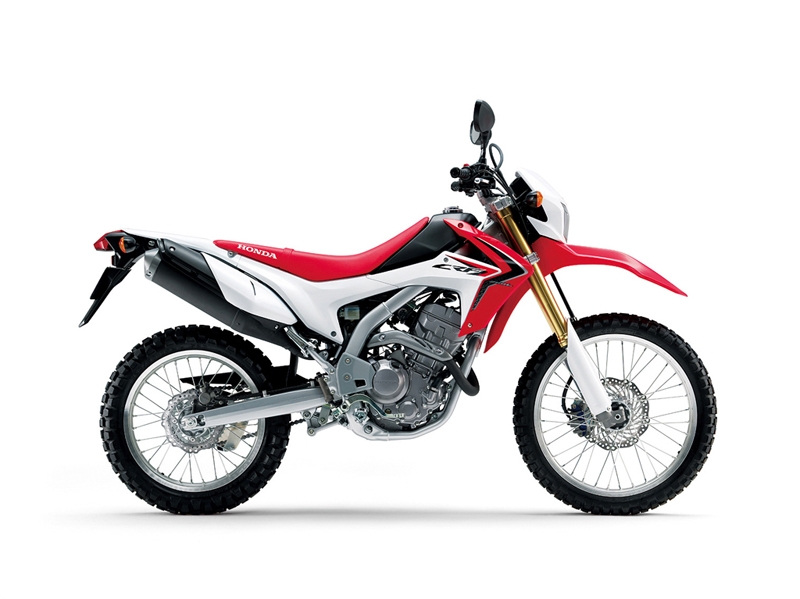 With dual-sport continuing to be the fastest growing segment of motorcycling, Honda has finally given us a modern motorcycle for this market. With their XR650L dating back to the time of the dinosaurs, and their illfated attempt at turning the popular CRF230F trail bike into a dual-sport for ’08-’09, it was time for Honda to step up to the plate, and the 2013 CRF250L might just be a home run. As a note, the CRF230L was not a bad motorcycle, but at $4,999 it was unable to compete against the competitively priced but more refined Yamaha XT250, and the more trail-focused Kawasaki KLX250s. With the introduction of the all new CRF250L Honda now undercuts both the XT250 and the KLX250s, putting the CRF in the lead as the new price class leader (only the Suzuki $4,199 DR200SE is cheaper, but is greatly outclassed in this crowd).
With dual-sport continuing to be the fastest growing segment of motorcycling, Honda has finally given us a modern motorcycle for this market. With their XR650L dating back to the time of the dinosaurs, and their illfated attempt at turning the popular CRF230F trail bike into a dual-sport for ’08-’09, it was time for Honda to step up to the plate, and the 2013 CRF250L might just be a home run. As a note, the CRF230L was not a bad motorcycle, but at $4,999 it was unable to compete against the competitively priced but more refined Yamaha XT250, and the more trail-focused Kawasaki KLX250s. With the introduction of the all new CRF250L Honda now undercuts both the XT250 and the KLX250s, putting the CRF in the lead as the new price class leader (only the Suzuki $4,199 DR200SE is cheaper, but is greatly outclassed in this crowd).
Unlike European dual-sports, which are typically hardedged dirt bikes with turn signals and a headlight, Honda constructed the new CRF250L from scratch as a purpose-built small displacement dual-sport. This means that you won’t find ground-breaking single-track performance in the new CRF, but you will find a motor that is well balanced with a smooth counterbalanced single cylinder. The CRF was designed with the one-bike-in-the-garage approach making it as good a lightweight commuter as it is a weekend play bike.
Looking at the CRF250L we immediately paired it up against the KLX250s. Both have six-speed transmissions, four-stroke liquid-cooled motors, inverted forks, digital dashes, near-35-inch seat heights and two-gallon gas tanks. The difference is that the KLX250s has a dirt heritage (and technology) dating back to the ’90s, and it’s still carbureted, whereas the CRF250L is a new design for 2013 with fuel injection. The potential for the new budget-priced CRF250L to crush the KLX250s made us salivate at the opportunity to ride them back-to-back and see for ourselves.
THE COMPARISON...
On the Street
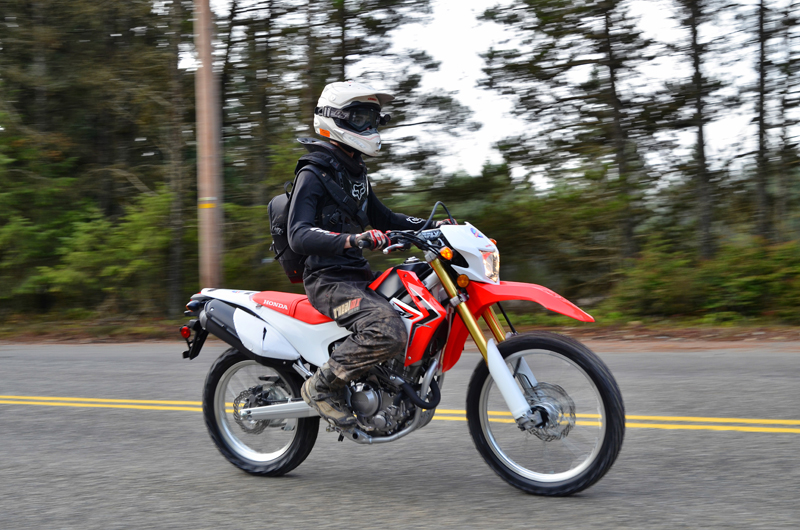 We spent a little time on the street, riding from trailhead to trailhead on lazy country roads, so we cannot attest to the CRF’s highway manners, but on the backroads it carved the corners as well as any dualsport with a smooth and refined manner. For a first-year model, the fuel injection was surprisingly well sorted out. The 249cc motor was plucked straight from the CBR250 and tuned for DS duty; this power plant has a good history already, so maybe we should have had more faith… after all it is a Honda.
We spent a little time on the street, riding from trailhead to trailhead on lazy country roads, so we cannot attest to the CRF’s highway manners, but on the backroads it carved the corners as well as any dualsport with a smooth and refined manner. For a first-year model, the fuel injection was surprisingly well sorted out. The 249cc motor was plucked straight from the CBR250 and tuned for DS duty; this power plant has a good history already, so maybe we should have had more faith… after all it is a Honda.
On the Trails
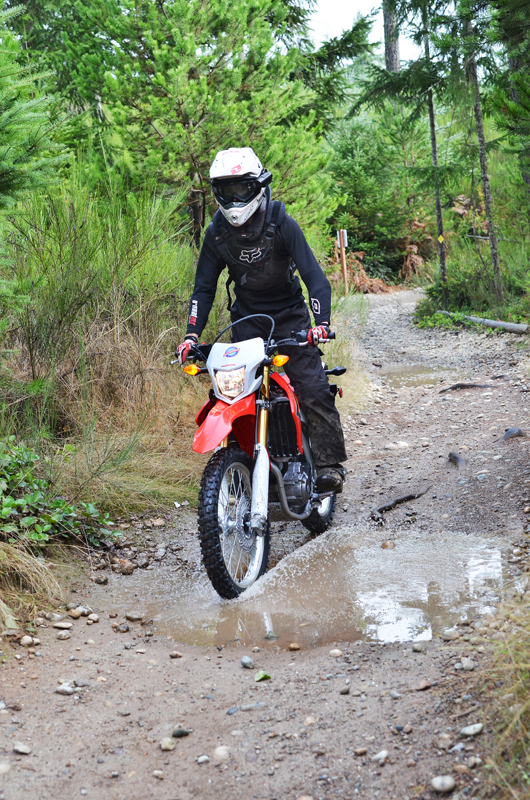 The first time I lifted the CRF250L off its side stand it was obvious this is not a light bike by 250 standards. Honda claims a curb weight of 320 pounds, which is three pounds heavier than a DRZ400s, and nearly 23 pounds heavier than the Kawasaki! But like so many Hondas that weight melts away as soon as the wheels begin to turn, letting you forget all about it until you have to pick it up on the side of the trail. The only time we noticed the extra heft was riding over rough surfaces where the budget suspension became obvious while the back end jumped from side-to-side and bottomed out while scratching for traction. Maybe if there had been an XT250 with us we wouldn’t have noticed this as much, but against the well suspended KLX250s it was the CRF’s greatest and most obvious weakness. Where we could ride the KLX250s over whoops, climb hills and jump over small obstacles, at nearly dirt bike speeds, the Honda had to be ridden much slower.
The first time I lifted the CRF250L off its side stand it was obvious this is not a light bike by 250 standards. Honda claims a curb weight of 320 pounds, which is three pounds heavier than a DRZ400s, and nearly 23 pounds heavier than the Kawasaki! But like so many Hondas that weight melts away as soon as the wheels begin to turn, letting you forget all about it until you have to pick it up on the side of the trail. The only time we noticed the extra heft was riding over rough surfaces where the budget suspension became obvious while the back end jumped from side-to-side and bottomed out while scratching for traction. Maybe if there had been an XT250 with us we wouldn’t have noticed this as much, but against the well suspended KLX250s it was the CRF’s greatest and most obvious weakness. Where we could ride the KLX250s over whoops, climb hills and jump over small obstacles, at nearly dirt bike speeds, the Honda had to be ridden much slower.
The rear suspension is noticeably under-sprung and under-dampened at even a modest pace. At six feet and 190 pounds I noticed this more than our 5'10" 150-pound tester did, but even he found the CRF250L unsettled when the pace was turned up. If your idea of a day of dualsporting includes sitting down while riding backroads, forest roads and a connecting trail once in a while, the CRF250L may be the perfect bike for you, and for many it will be. If your days are spent in search of new single track, you’ll soon discover the budget suspension on the CRF250L and may want to ride the competition before laying your money on the table. The Kawasaki has been the suspension class leader since its introduction in 2006, and is challenged only by the $6,690 WR250R. Suspension is undeniably the CRF’s greatest weakness.
The motor on the CRF250L feels modern, with a crisp quick start regardless of weather or temperature and requires almost no warm-up. No fuss, fancy routines, or patents required. The carbureted KLX250s motor often requires patience, a starting “routine” and some time to let things warm up to get it going. Power between the CRF250L and the KLX250s felt similar with only the delivery of momentum differing. The CRF has a smooth linear delivery, whereas the KLX250s has a snappy rev-happy delivery which requires more shifting to keep it in the happy spot. One is not better than the other, only different, as both me and the other tester had our favorites. As a dirt rider, I preferred the “snap,” of the KLX250s, whereas the other tester often preferred the CRF250L. What the Honda lacks in “snap” it makes up for in a confidence-inspiring linear delivery of power in any gear, at any time. This is not the bike if your idea of a fun day is jumping or powering over obstacles, but riders new to the trail will find it a comfortable, familiar friend in no time at all.
We both preferred the Kawasaki when standing up on the trails, noting the handlebar-to-peg height felt more natural, and the KLX also felt narrower between the legs. However, when sitting, the Honda received the thumbs up with a far more comfortable seated position on the broad comfortable seat—certainly an advantage if used for commuting or travel. The weight distribution on the Honda is neutral and as we mentioned, the extra heft is forgotten when the bike goes into motion. If you spend much time picking your bike up it’s a little more noticeable, and I’d like to see Honda find a way to put the CRF on a diet.
Fit n' Finish
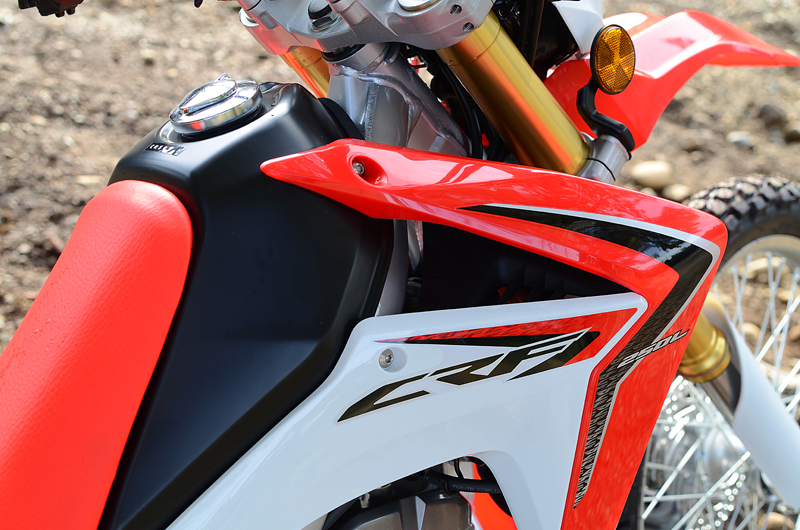 The CRF250L is typical Honda with bodywork that integrates cleanly, hiding unsightly fasteners and seams, in a level of refinement generally reserved for street machines. The controls are well designed, easy to use and blend into the rest of the bike. First glance confirms the CRF250F is no parts-bin bike or a “slap some signals on it and call it a dual-sport” bike. The CRF250L is Honda’s salvo shot across the bow of its competition, letting the world know that this Honda is a serious contender. The CRF even has a locking tool box on the left side of the bike that blends perfectly into the body panels and can be easily removed. When removed the tool box leaves clean lines with hardly any evidence it was ever there… nice touch Honda! The seat is broad and well finished, and indicates it will become the class leader in comfort when riding on the street. The foot pegs are also best-in-class, being wide and cleated for traction with large open spaces to easily clear mud.
The CRF250L is typical Honda with bodywork that integrates cleanly, hiding unsightly fasteners and seams, in a level of refinement generally reserved for street machines. The controls are well designed, easy to use and blend into the rest of the bike. First glance confirms the CRF250F is no parts-bin bike or a “slap some signals on it and call it a dual-sport” bike. The CRF250L is Honda’s salvo shot across the bow of its competition, letting the world know that this Honda is a serious contender. The CRF even has a locking tool box on the left side of the bike that blends perfectly into the body panels and can be easily removed. When removed the tool box leaves clean lines with hardly any evidence it was ever there… nice touch Honda! The seat is broad and well finished, and indicates it will become the class leader in comfort when riding on the street. The foot pegs are also best-in-class, being wide and cleated for traction with large open spaces to easily clear mud.
*For a list of other great small displacement adventure bikes, check out our Best Used 250cc Adventure/Dual-Sport Bikes article.
Conclusion
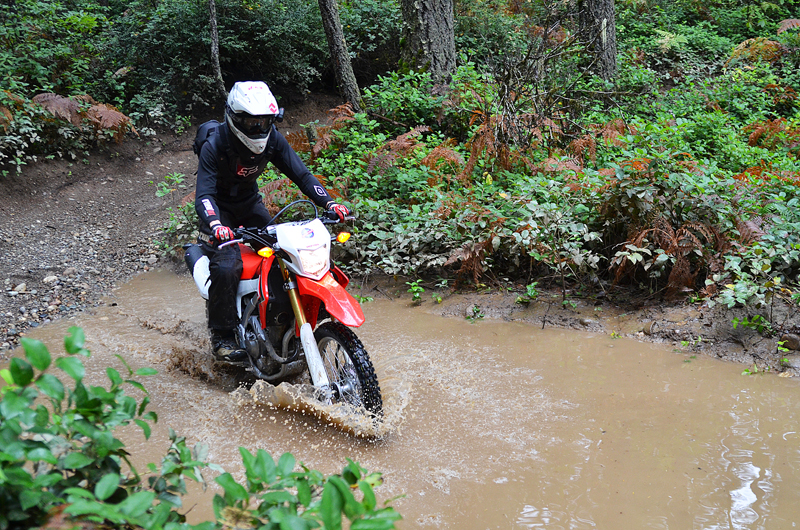 I am predicting Honda has a winner here and will be surprised if they don’t sell like crazy. Classed against the KLX250s, it is easy to see that the CRF250L is an all-new design that was built to be a dual-sport equally comfortable on the street as on easy trails and backroads. The pros of the CRF250L far outnumber the cons and it beckons scores of new and experienced riders into the world of dual-sporting. On the trail the KLX250s was the clear favorite with a more responsive motor, superior suspension and a thinner, more dirt-focused feel, but when competing for the fat part of the market the CRF250L is more likely be competing against Yamaha’s fuel injected XT250, which is more a 50/50 bike, rather than the 70/30 dirt/street bike, that we would consider the KLX or the other 95/5 dual-sports by KTM, Husaburg, Husqvarna or similar European manufacturers.
I am predicting Honda has a winner here and will be surprised if they don’t sell like crazy. Classed against the KLX250s, it is easy to see that the CRF250L is an all-new design that was built to be a dual-sport equally comfortable on the street as on easy trails and backroads. The pros of the CRF250L far outnumber the cons and it beckons scores of new and experienced riders into the world of dual-sporting. On the trail the KLX250s was the clear favorite with a more responsive motor, superior suspension and a thinner, more dirt-focused feel, but when competing for the fat part of the market the CRF250L is more likely be competing against Yamaha’s fuel injected XT250, which is more a 50/50 bike, rather than the 70/30 dirt/street bike, that we would consider the KLX or the other 95/5 dual-sports by KTM, Husaburg, Husqvarna or similar European manufacturers.
If you are looking for an inexpensive small displacement dual-sport to commute, travel and trail ride, the 2013 Honda CRF250L may be the perfect bike for you costing $600 less than the KLX250s, $691 less than the XT250 and a whopping $2,191 less than the Yamaha WR250R!
Check out the transformation of our CRF250L Project bike!
https://adventuremotorcycle.com/bikes/bikes-honda-crf250l-review/all-pages#sigProId90c6310ef6
PROS | CONS |
| ▲ Fresh new purpose-built dual-sport. | ▼ Budget suspension and it feels like it. |
| ▲ Fuel injection that works well (no more cold morning starting routines). | ▼ The heaviest 250 dual-sport on the market. |
| ▲ Typical Honda fit and finish. | ▼ Least ground clearance in it's class. |
| ▲ The price leader in the small dual-sport market. | |
| ▲ Smooth predictable power delivery. | |
| ▲ Ride the trails on the commute home from work. | |
| ▲ Easy-to-use digital gauges. |
HONDA CRF250L | KAWASAKI KLX250S | YAMAHA XT250 | |
| MSRP | $4,499 | $5,099 | $5,190 |
| ENGINE | Four-stroke, 249.4cc liquid-cooled, DOHC, four-valve single | Four-stroke, 249cc liquid-cooled, DOHC, four-valve single | Four-stroke, 249cc air-cooled, SOHC 4-stroke single |
| BORE X STROKE | 76.0 x 55.0mm | 72.0 x 61.2mm | 74.0 x 58.0mm |
| COMPRESSION RATIO | 10.7:1 | 11.0:1 | 9.5:1 |
| INDUCTION/ CARBURETION | PGM-FI, 36mm throttle body fuel injection | 34mm Keihin carburetor | Fuel injection |
| TRANSMISSION | 6-speed | 5-speed | 6-speed |
| FRONT SUSPENSION | 43mm inverted fork; 8.7 inches travel | 43mm inverted cartridge fork with 16-way compression damping adjustment/10.0 inches travel | 35mm telescopic fork; 8.9 inches travel |
| REAR SUSPENSION | Pro-Link® single shock with spring; 9.4 inches travel | Uni-Trak® with adjustable preload, 16-way compression and rebound damping adjustment; 9.1 inches travel | Rebound-adjustable single shock; 7.1 inches travel |
| FRONT TIRE SIZE | 3.00-21 | 80/100-21 | 2.75-21 |
| REAR TIRE SIZE | 120/80-18 | 100/100-18 | 120/80-18 |
| BRAKES | Front 256mm disc with twin piston caliper, rear single 220mm disc | Front 250mm semi-floating petal disc with two-piston hydraulic caliper, rear 240mm petal disc with single-piston hydraulic caliper | Front 245mm disc, rear 203mm disc |
| SEAT HEIGHT | 34.7 in. | 35.0 in. | 31.9 in. |
| GROUND CLEARANCE | 10.0 in. | 11.2 in. | 11.2 in. |
| FUEL CAPACITY | 2.0 gal. | 2.0 gal. | 2.6 gal. / California model 2.4 gal. |
| CURB WEIGHT | 320 lbs. | 297.7 lbs. | 291 lbs. |





